#but my twitter addiction dates back to 2008
Text
Folks please leave Twitter
it is The Bad Place.

#twitter#andrew tate#elon musk#and yes i am aware the of the irony of using a screenshot from twitter so don't bother pointing it out#I have moved to Bluesky almost fulltime#but my twitter addiction dates back to 2008#It's a process
8 notes
·
View notes
Text
**Social media- **what is and what it does
I have since a very long time been monitoring the use of social media.
To be honest growing up i was quite hesitant to be on social media as i thought it would drown my brain.
But today we're here with you to discuss the good and the bad of social media that are used in todays adolescents.
First of we need to know what social media is:
Social media refers to websites and applications that are designed to allow people to share content quickly, efficiently, and in real-time.
Social media is also seen as a platform for many groups and ethnicities.
For many it is seen as as a show case of talents, entertainment,personalities, characteristics, and especially their voices.
Next we need to know the platforms they used:
the youths that we've primarily come across upon use the social media outlets:
Instagram
Snapchat
Twitter
Facebook
Whatsapp
Tik Tok
Youtube
Tumblr
To begin with comprehending our youth we need to understand what they use their outlets for.
You can see many of todays youths on social media. Some using it as their personal platform others using it to conceive trends, observing nearly worshipping their idols, forms of communication, its also a look into the daily lives of each other.
For instance: celebrity crush and idols
they are the people kids look up to and use as their role models or envision themselves in that role one day whether be reality or a dream.
It gives them something to reach out to, sort of like a goal
As for media entertainment
we all know the use of memes and the use of it for our personal comic relief.
We all spend countless hours looking at memes and youtube videos but what if we could use this entertainment to stimulate and help evolve the adolescent brain development.
In the form of generating their own memes or social vids that are informative.
Gaming and YouTube has vastly taken over the social platform stage.
They are also some of the more novice lucrative ways of making money on a social platform.
Take for instance that recently there was a video game tournament for fortnite where a young teen won over a million dollars by becoming its first tournament winner.
And what better way to broadcast that same tournament but on YouTube.
Where millions of viewers logged in and the broadcaster got paid by the sum of viewers he/ she had.
Psychoanalysis was founded by Sigmund Freud (1856-1939). Freud believed that people could be cured by making conscious their unconscious thoughts and motivations, thus gaining insight.
The aim of psychoanalysis therapy is to release repressed emotions and experiences, i.e., make the unconscious conscious. It is only having a cathartic (i.e., healing) experience can the person be helped and "cured."
Click here for a video on the theory of psycho analysis
psycho analysis is crucial to understand because if we do then we know our brain develops even in our sleep. And if teens constantly are on social media or social networks and video games it can affect their sleep and the wake up restless, or even worse more dedicated to the social outlets as not to feel left out.
One way we can help beat this is 3 hours before bed time all phones away and give the brain a stimulating activity so that it can function up to speed and breathe and eat knowledge as it is meant to .
Implement family night with boardgames or trivia or a fun activity outsides that can help build your social recognizance.
Giving your body and brain diversity keeps it sharp and uplifting and gives you those extra tools for life.
For instance some of the social idols for todays teens can be what we call social influencers.
A social influencer is someone who uses their social media status to push products on their young audience to buy said product on their social media page for what said influencer is paid for by the brand.
See video: https://www.youtube.com/watch?v=5SOFSjlU0fM
on a site called mom junction I found 11 positive and negative influences of teen on social media
https://www.momjunction.com/articles/positive-and-negative-influences-of-media-on-teenagers_00107975/
I will just use 2 of each:
Help Develop Social Skills:
Many teens are socially awkward. Media gives them the chance to groom their social skills. It also gives them the chance to expand their social circle and develop new friendships. Other benefits include social confidence, heightened literacy in the media, and more social support. Social media diversifies your teen’s social skills, which in turn helps him navigate successfully through modern society
Inspire Them:
When your teen watches an action flick, don’t just despair about the violence. With a little guidance, they can use the movie as inspiration! Maybe your teen will decide to take up martial arts training, all thanks to a Bruce Lee movie! Teenagers look up to celebrities, and when a celebrity tells them to stay off drugs, they just might listen.
Negative theories
Risky Sexual Behavior:
Teenagers are just discovering their sexuality. It is very normal for them to be interested in everything sexual. But the amount of sex in media today can make a teenager confused. Sex without responsibility – that seems to be the message being beamed at teenagers. This can lead to irresponsible sexual behavior and unwanted pregnancies.
[ Read:Teenage Social Media Addiction]
Making Everything Commercial:
Happiness comes at a price. At least that’s the message teenagers get through media. Their life would be perfect if only you’d buy them that hot new game, that happening dress. Advertisers target teenagers to ramp up their revenues. But teenagers fall prey to the idea of commercialization of happiness.
According to Erickson’s Developmental theory, an individual faces a developmental crisis at each stage ( a conflict between a positive alternative and a potentially unhealthy alternative). “…The emphasis on ones own identity at a point in time when the way forward was no longer determined by ones parents or by society…resulting in a crisis of identity”. (westenberg 2008:2)
Now that we have that tackled, let us discuss some of the good of social media:
Ive mentioned previously above that social media is a platform:
for instance the parkland shooting in the united states where a group of students took to social media to voice their opinions after surviving yet another tragic massacre and became activist in their own rights to fight against NRA and force a national debate.
https://www.vox.com/2018/2/26/17054408/parkland-shooting-activist-teens-gun-control
if we were to apply Urie Bronfebenner's theory of Ecological Theory of Human Development.
Urie Bronfenbrenner (April 29, 1917 – September 25, 2005) was a Russian-born American psychologist who is most known for his ecological systems theory.[1] His work with the United States government helped in the formation of the Head start program in 1965.[2] Bronfenbrenner's ability research was key in changing the perspective of developmental psychology by calling attention to the large number of environmental and societal influences on child development.
Or young high school or college students or athletes using their popularity on social media to spread the knowledge of social injustice
As you can see young adults have used social media to help lead them along the way to do great things these are the most beautiful forms of social media.
Then of course there is the ugly.
Social media is also an open platform, for some it can allow you to be subsequent to
for instance research has shown that spending to much time on social media can lead lead to depression .
As noted by such research sites such as ivesciences
https://www.livescience.com/51294-cyberbullying-social-media-teen-depression.html
Don't get me with twisted everything in this life there are the good and the bad.
Take for instance social media have given us the means to reach millions if not billions of people across the globe to relay our message but it can also allow you to portray just a an image of yourself but factual and superficial.
CYBERBULLYING
Do you know the dangers of cyber bullying?
Cyber bullying has taken on one of the worst form of emotional en mental damage to it's victims.
There have been an extreme amount of cyber bullying that has led to the victims committing suicide.
I don't know about you but no child should have o go through so much that they rather take their own lives because of such cowardly behavior from another that hides behind a sometimes fake profile.
Here is an article from lie science backing thees findings:
https://www.livescience.com/51294-cyberbullying-social-media-teen-depression.html
For instance in adolescents cat fishing has been major issue.
For those who don't know catfish(ing ) is pretending to be someone your not on he internet/ social media .
The most cat-fishers claim to show interest in you and try to either make you fall in love with them or to manipulate you for their own personal cause.
https://socialnewsdaily.com/11296/catfishing-infographic/
Cat-fishing is often employed for romance scams,on dating websites. Cat-fishing may be used for financial gain, to compromise a victim in some way, or simply as a form of trolling or wish fulfillment.Sadly the study found that cat-fishers will use traumatic experiences such as cancer, accidents and death to avoid meeting their victims in real life.
As we look into the psychological make up of cat-fishing its almost always done by one person making of a fake social media platform. It is because it is so easy to mask our through selves behind the windows of social media. Another bad reference is that it is now easier for bullies and psychopaths to reach our youth online through social media.
Other platforms with social media use
Lets take a look into the platform that our adolescents role into.
For instance youtube, youtube was seen for many years as just a media outlet where we could watch short documentaries and comedy stints and especially watch music videos.
Nowadays youtube has a huge role into social media and social development of todays youth.
Yes i know the argument would come as wow really (sarcastically) and others would say thats always been the way it has been ( true) but never like before.
Just a few insight as to what goes on you tube you can see stuff like live video gaming where you can talk to and relate your skills.
https://www.youtube.com/watch?v=ft54bgeMBlg
https://www.youtube.com/watch?v=Qc-vvpFft2c
https://video.fosterwebmarketing.com/fosterwebmarketing.com/httpdocs/evm/1080_fosterwebmarketing_017_gina_youtube_h264_640x360.mp4
Also where the can communicate with anime pages, show their life with life vlogs and star in their own reality clips, put on their own personal showcases with live interaction.
The've built up a platform where they can showcase their many talents.
For instance Justin Bieber himself was discovered on youtube and signed a record deal as a teenager.
But social media can also lead to the a substantial difference to the development of the adolescent brain, if you click on the lick here under you can see a couple of test run on teenagers who are on social media and how their brains develop.
https://www.youtube.com/watch?v=7QWoP6jJG3k
**Where do i belong **
We have seen an outstanding amount of young people all searching to find their peers and to adhere to whatever social group.
Take for instance such support groups that help them deal with their sexuality, ideology and identity
LBGTQ
Feminism
race
beliefs & religion
sex & sexual experimenting
social experimenting
every teen wants to find his or her social group or spot in society; and social media in its various forms helps to steer them to that source.
We should always pay attention to our students and kids for they are discovering their paths be it good or bad they will find person or social peers who share their interest.
Piaget (1936) was the first psychologist to make a systematic study of cognitive development.
Sensorimotor stage: birth to 2 years
Preoperational stage: ages 2 to 7
Concrete operational stage: ages 7 to 11
Formal operational stage: ages 12 and up
The Sensorimotor Stage
Major Characteristics and Developmental Changes:
The infant knows the world through their movements and sensations
Children learn about the world through basic actions such as sucking, grasping, looking, and listening
Infants learn that things continue to exist even though they cannot be seen (object permanence)
They are separate beings from the people and objects around them
They realize that their actions can cause things to happen in the world around them
During this earliest stage of cognitive development, infants and toddlers acquire knowledge through sensory experiences and manipulating objects. A child's entire experience at the earliest period of this stage occurs through basic reflexes, senses, and motor responses.T
The Preoperational Stage
Major Characteristics and Developmental Changes:
Children begin to think symbolically and learn to use words and pictures to represent objects.
Children at this stage tend to be egocentric and struggle to see things from the perspective of others.
While they are getting better with language and thinking, they still tend to think about things in very concrete terms.
The foundations of language development may have been laid during the previous stage, but it is the emergence of language that is one of the major hallmarks of the preoperational stage of development
The Concrete Operational Stage
Major Characteristics and Developmental Changes
During this stage, children begin to thinking logically about concrete events
They begin to understand the concept of conservation; that the amount of liquid in a short, wide cup is equal to that in a tall, skinny glass, for example
Their thinking becomes more logical and organized, but still very concrete
Children begin using inductive logic, or reasoning from specific information to a general principle
While children are still very concrete and literal in their thinking at this point in development, they become much more adept at using logic.2 The egocentrism of the previous stage begins to disappear as kids become better at thinking about how other people might view a situation.
The Formal Operational Stage
Major Characteristics and Developmental Changes:
At this stage, the adolescent or young adult begins to think abstractly and reason about hypothetical problems
Abstract thought emerges
Teens begin to think more about moral, philosophical, ethical, social, and political issues that require theoretical and abstract reasoning
Begin to use deductive logic, or reasoning from a general principle to specific information
The final stage of Piaget's theory involves an increase in logic, the ability to use deductive reasoning, and an understanding of abstract ideas.3 At this point, people become capable of seeing multiple potential solutions to problems and think more scientifically about the world around them.
In theory we as teachers should not fear the use of social media but instead learn to harness its powers.
To use it as our umbrella to educate by implementing it into our lessons we can control it for the mos.
For instance the making of a social media portfolio where they can use social media better in there english class and basically amy skill set you want to embody on todays adolescents.
For some of us with teenage students we can find it off putting but by my observations there are some differential factors in the use of social media and their personal development from said social society.
Some of the factors are :
Culture/ region of upbringing
Race
Morals and values
Religion
and of course age
With all of these factors we should always monitor our children/ students and have them take time for a detox.
We should also try not to hover over them but enlighten them and instead of nag give them a sense of responsibility where then their brain can develop in multiple ways. Think of it as exercise for the brain.
**Live Long and Prosper & Remember to Elevate and Educate **
1 note
·
View note
Photo

[Fun] Let’s talk about our favorit actors and why we would do 'everything' to make him/her smile^^
welcome to post 1.001
yes, I couldn’t belive it myself... I made 1.000 posts in less than a year O_O
I guess you can call me an addict 笑
so using this occasion...
I want to give something I tried before (September 2017) a 2nd chance^^ (maybe this time people will tell me about their favorit actor/actress笑)
I really want to know so please tell me about your №1 + you can read about mine under the cut (ᵔᴥᵔ)
I really ♡ Nakamura Yuuichi (中村優一; ← actor, not seiyuu!!!! )

He is and will ever be the person I will LOVE the most of all those j-actors^^
He is such a lovely dork and I really like his smile.
Some facts first:
① born October 8, 1987 [he is 2½ weeks older than me笑]
② nickname ~Channaka~「ちゃんなか」(Naka-chan backwards)
③ best known for his role ‘Sakurai Yuuto’ (Kamen Rider Zeronos) in Kamen Rider Den-O (2007)… but did you know that he actually played ‘Kiriya Kyousuke’ in ‘Kamen Rider Hibiki’ (the first actor to portray 2 Kamen Rider)


④ assigned to G-Star.Pro ( ジースター・プロ )
⑤ has 2 Chihuahua ~Zero~ (Kamen Rider Zeronos) & ~Spica~ ↓ ↓ ↓ (Futatsu no Spica)

⑥ was part of Johnny’s Jr. (~2003)

⑦ had poor health as a child (asthma) [same here!!! in and out of the hospital]
⑧ loves reading shoujo-manga (ex: Good Morning Call グッドモーニング・コール / he had a cameo in the drama adaptation epi.15/16) and listening to jpop (Shounan no Kaze, Kis-My-Ft2, EXILE, CHEMISTRY, AAA ← friends with Nishijima Takahiro & Atae Shinjirou since ‘Delicious Gakuin’)
⑨ former member of a group of actors called D-Boys
as I talked about in one of my earlier posts… I really feel connected to Channaka and he kinda ‘helped’ me during the hardest time of my life. [check out my post about ‘Doukyuusei’ if you want to know why^^]
… when I heard he would be in the special unit called D☆DATE (together with Araki Hirofumi, Igarashi Shunji, Seto Koji & the new member Horii Arata) in 2010, I was so happy for him… because he deserved some more attention! He is one of the few boys who didn’t act in Tenimyu and that was really hard for him, because most of the D-Boys acted in it and became kind of “famous” for it.
In interviews he often talked about that he couldn’t get over the fact the he didn’t have a chance to be in Tenimyu and he couldn’t understand why, especially because he came out first at the 1st D-Boys audition.
And finally he got the attention he deserves, the most unthinkable thing ever happened. Right before his new stageplay (D-BOYS STAGE 2010 trial-2 ラストゲーム ) it was announced that he will take a break from work to cure his ‘chronicle back pain’. It was a huge shock for me because they announced it right before I moved to Japan. I still remember that I was sitting on my packed boxes in the livingroom when my friend called and told me the news…
almost a 1 year later we still had no real information about his condition… it was really depressing. I went to almost all D☆DATE events wearing orange things/stars (his member colour) and was even on TV (はなまるマーケット hanamaru market) with these ↓ ↓ ↓ uchiwas ↓ ↓ ↓ just to show that we were still waiting for him T^T


At the 1st Concert Tour of D☆DATE we finally got some ‘news’. They talked about him, said that it’s sad he couldn’t make it in time for the concert, but he would be trying his best to show up on stage again as soon as possible.
I was crying while they showed pictures of him during the con because I felt so helpless.
After all the terrible things that happend in the first half of 2011 (the Fukushima-incident, the sudden death of my aunt, trouble with my former workplace…) I was kinda happy to hear that Channaka was still part of the group and the members where all waiting for his comeback!!! I thought that it would be only a matter of time until I could finally see him safe and sound on stage again… I was soooo motivated that I created a photo album with many pictures from fans all around the world to cheer him up and show him that soooooooooooo many people are waiting for him!!! I wrote the first fanletter (~8pages) of my life and told him that his fans would always support him and would wait for him as long as it would take for him to recover… and I wrote something that some fans would never understand… ‘If you wanna quit, don’t worry about us… we will respect your decision!!’ actually there is a reason why I wrote something like that…
I heard from a friend who worked as a model for Watanabe Enertainment, that he had no ‘back-pain-problems’ at all!!! He was suffering from depression… [he had a hard time in August 2010 and realised that he couldn’t perform with this unstable condition, so he stopped coming to rehearsal 2 weeks before the actual stage… I can understand that the other D-Boys member were not amused about it… but what I heard from my friend made me really sad: they started to bully Channaka and told him to quit… especially the D☆DATE members didn’t want him to come back!!!… from my experience with the industry in Japan, this is quite common (especially Johnny’s Enertainment) but I still find it hard to understand] ← I got this information from a friend, no official statement!!! + I don’t hate any D-Boys members… I’m just sad about the fact at all!!!
And than,on November 8th, 2011 (4 weeks after I handed out my letter & 2 weeks after my B-day) it was announced that he would retire from D☆DATE/D-Boys _| ̄|○
(I had never expected that this would happen… I cried a lot!! who would think that this little sentences in a little fanletter from a little foreign girl would come reality. I don’t believe that it was the trigger for his decision… but still… the timing… I was shocked)
The ‘official’ statement was ‘in order to recover he needs to conentrate on rehabilation more’… but I couldn’t believe this anymore!!!
The following year Watanabe announced that he would completely retire from the entertainment world and I was crashed…
I met soooo many people from the industry (not only because I went to a lot of events… my job gave me the opportunity to meet a lot of people in private) but the only person I ever wished to meet in Japan ‘disappeared’ and my chances to ever see him in person were almost 0…
And than in the beginning of 2013, he all of a sudden started his new blog where he posted pictures of him posing with friends (O_O) Rumors started to spread that he opened up a café/bakery with a friend (but I have no detailed information about that). I was so relieved that he was doing fine^^
AAAAAAAND 1½ years later the best thing ever happened!!!!
August 30th, 2014: Nakamura Yuuichi returned to the entertainment industry.
I was jumping up and down in my room, called my best friend (who isn’t even a fan at all笑) and poured my whole soul out^^
It took a while for him to come back on screen, but it was worth waiting for!!!
The first role he represented after his comeback was ‘Sakurai Yuuto’ in ‘Superhero Taisen GP Kamen Rider 3 Gou’ (スーパーヒーロー大戦GP 仮面ライダー3号)
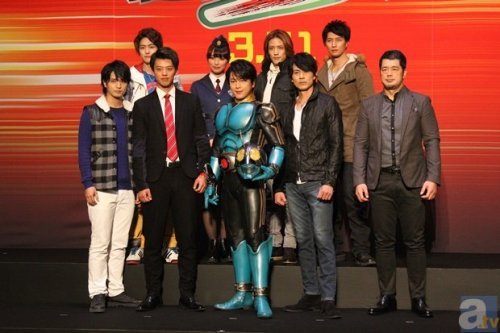
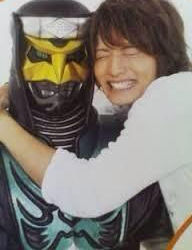

I think you get it by now… Kamen Rider Den-O (Sakurai Yuuto/Ootsuka Houchuu aka Denebe) means a lot to him!!! and if you are still not convinced… try to listen to the recording from ‘Kamen-Raji-Ranger 仮面ラジレンジャー’
I was at the venue when they recorded the show T^T aaaaaand just for the records…
this was the first time seeing him in person right in front of me!!!!!!!!!!!!! (August 18th, 2015 will go down in history^^) can you believe it… it took me almost 5 years to meet him (O_O)

(the pic I posted on twitter after I saw his post^^)
since then he acted in soooo many great productions and had a few leading roles (薄桜鬼SSL ~sweet school life~ / 舞台 裁判長!ここは懲役4年でどうすか 2016 / スレイブメン / 舞台 警視庁抜刀課 / 舞台 BRAVE10/ 舞台版 ヘルプマン! ~監査編~ / 最後の晩ごはん)
Seeing him working this hard after all that happend in the past, I decided that I will follow and support him as a fan for the rest of my life笑 He will always be my №1 ♡
If you feel like supporting him or just got interested in him… here are some things I recommend:
① check out his:
twitter
official blog
wikipedia
② (re-)watch Kamen Rider Den-O
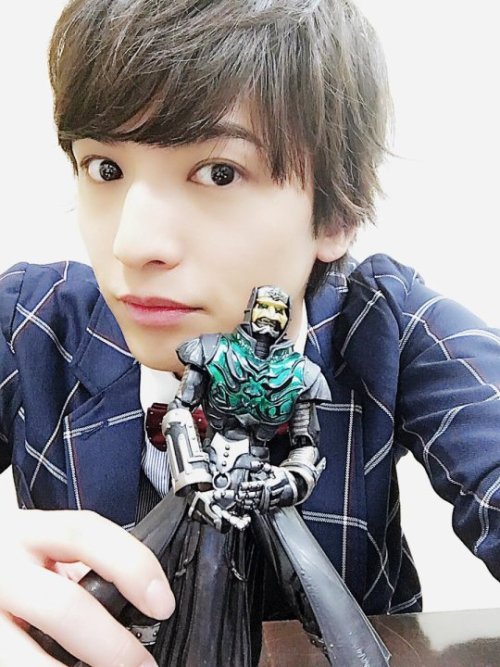
③ take a look at his photobooks^^

1st shashinshuu (2008)

2nd photobook (2010)

aaaand his new photobook (was released October 8th, 2017 to celebrate his 30th B-day)
④ if you want to get emotional… watch:
Doukyuusei [同級生]
Futatsu no Spica [ふたつのスピカ]
D-Boys Stage Vol.3: Karasu [10 D-BOYS STAGE vol.3「鴉~KARASU~」-10]
⑤ or consider buying any kind of media you might be interested in^^
if you made it to this point… thx for sticking along!!!! ♡
I would love to hear/read from you about your №1 and maybe some thoughts about Nakamura Yuuichi^^
and last but not least my best off Nakamura Yuuichi (more pics... sorry笑)









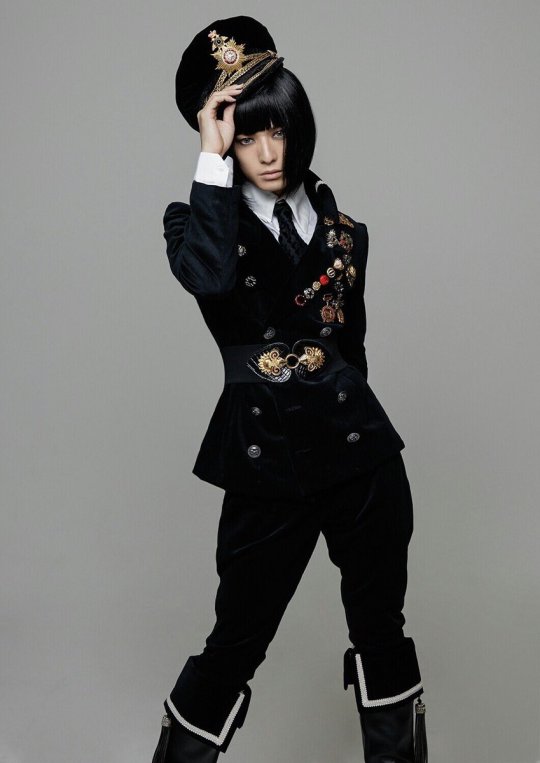













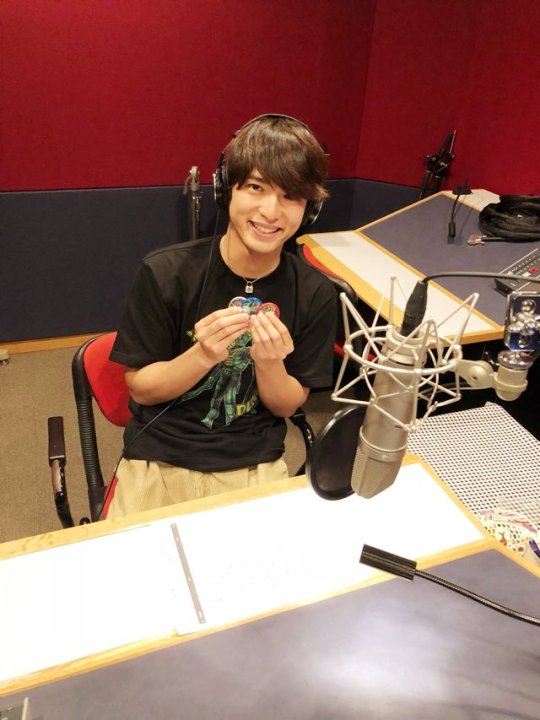










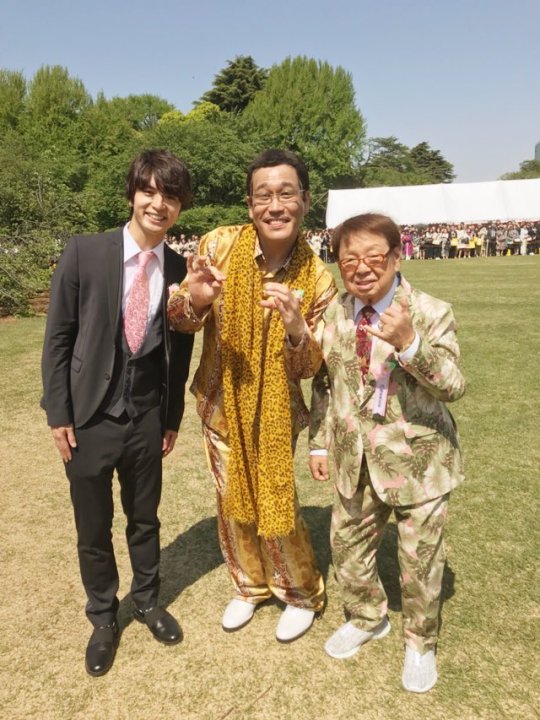

#中村優一#nakamura yuuichi#jactor#who is your favorite#just me being a fan#tell me about your №1#i would love to hear your thoughts
19 notes
·
View notes
Text

U.S. comedian Kathy Griffin says she has lung cancer
NEW YORK
Outspoken U.S. comedian Kathy Griffin, whose decades-long stand-up career was briefly derailed in 2017 after a grisly stunt with a prop depicting Donald Trump's severed head, said Monday that she has lung cancer.
"I'm about to go into surgery to have half of my left lung removed. Yes, I have lung cancer even though I've never smoked!" Griffin, 60, said in a statement posted on Twitter.
She said her doctors were optimistic as the cancer was stage one and confined to her left lung, and that she was not expected to have to undergo chemotherapy or radiation.
"I should be up and running around as usual in a month or less," she said.
Griffin is a trailblazing comedian whose first album "For Your Consideration," released in 2008, was the first by a woman to debut at the top of the Billboard comedy charts.
She went on to release five more albums, and has appeared in multiple films and television shows throughout her stand-up career.
But in 2017 the award-winning performer posed with a prop depicting then-president Donald Trump's severed, bloodied head.
Though she rapidly back-pedaled and apologized, the stunt cost her a job with CNN and united conservatives and liberals in outrage.
Griffin has since spoken publicly of the abuse she has received, telling ABC News in an interview published Monday how it helped drive her to a painkiller addiction and even attempted suicide.
"The irony is not lost on me that, a little over a year ago, all I wanted to do was die. And now, all I wanna do is live," she said in the interview.
"It's been a helluva 4 years," the comedian wrote in the Twitter statement, adding: "but I'm gonna be just fine."
She was vaccinated against COVID-19, she said, adding: "The consequences for being unvaccinated would have been even more serious."
"Please stay up to date on your medical check ups," she wrote. "It'll save your life."
0 notes
Text
So I did the “get to know me” meme on Twitter but because of how Twitter functions now it’s a hard to follow mess of a thread. Decided to post it all here -- and hey, if any of ya’ll are curious, feel free to read.
1) When I was 10 my abusive stepdad threw a spray at me. I ducked -- it scraped my head. Sent to school bleeding b/c he was too stoned to realize it'd get noticed and I'd get pulled out of that environment immediately. This moment changed my life, left a scar on head.
If I hadn't ducked, would've hit my stomach. No cut. Whole childhood would've been different. My first Butterfly Effect Moment.
2) I started writing fiction about Pokémon. First-person, from the Mons perspective. Rotating point of view each scene.
3) I moved on to crazy crossover fanfic where I constructed an entire war, personal and political motivations, so many ideas I still like?
4) Part of this involved detailed drawings of Mario-themed Keyblades I wish I still had.
5) Paper Mario 1&2 are some of my most influential inspirations. expanded such a simple world so much so fluidly. (Harder than it looks)
6) When I was a kid my sister would wake me st like 6am to watch dubbed Sailor Moon. Bothered me they all sounded like same person.
7) I can recognize voices very well and even specific sounds and songs. Couple years back my roommate ran a test - playlist of 100 NES tracks, he'd play the first NOTE, singular, and I could recognize exactly where it was from if I'd played the game.
8) My first computer was a PC I bought w/$ saved up during an entire summer of custodial work in HS. Had no Internet.
So I'd use the public library's very slow connection to download things to floppy disk and copy them over.
Eventually, I was able to graduate to a USB. Obtaining music was hellish so I treasured each song I could download -- most from OC Remix.
9) We had this tiny rabbit ears TV that could get WB and Fox sometimes if it was set up in a specific corner of my sister's room
And so I would desperately use it to try and stay up to date on Pokémon and Digimon, it was so bad
10) Teen Titans was arguably the most influential piece of media for my teenage mind. It formed the base of so much I care about re:stories
Fleshed out, varied protags who grew together and each had their times to step up and step down. Action w/character dev context.
Fantastic themes important for growing humans; awesome moments "between the panels" instead of all comic book melodrama and action.
Then everything changed when TT GO attacked and pissed on everything smart and thoughtful because MONEYYYYY
11) Cowboy Bebop was the first "good" anime I ever saw and blew my mind open about what animated stories could do -- i.e. Not just kid stuff
I don't like "anime" in general because most of its common tropes but the shit out of me even worse than most western toon tropes
And yet like 50-75% of my most favorite shows ARE anime because thoughtful animated storytelling has so much potential.
11) I predicted months before Last of Us came out that you'd play as Ellie but when it happened I had to stop, cry happy tears.
I predicted the second I saw the Left Behind trailer what was going on w/those two and again, still had to stop and cry happy tears.
(I seem to have pretty good gaydar now but I also don't like, ship everyone together all the time)
It just hits me so hard when actual canon queerness happens in mass media and is done well, but we're still so bad at following through.
12) Favorite m/m ship: Troy and Abed in the Morning.
Favorite w/w ship: Max and Chloe BFF Pirates 2008.
ATLA ships: Tokka the most, also Katang, also Smellershot.
ATLA makes me more open to shipping than any other series?
Like, Zutara makes me feel kinda gross and some of the crack ships like Sokka/Azula scare me but otherwise I'm pretty chill w/ATLA ships?
13) When I was a kid, and we'd role play, I always wanted to play the girl characters. I was surrounded by boys so they always were weirded.
It was weird to me, too, honestly.
Now it makes perfect goddamn sense.
14) Apparently I was kidnapped as a baby by some mobster or something but it's hard to tell with my mom what's real or not.
15) Smash Bros. Melee was the first game I ever got genuinely hype over before launch. I still remember being startled to discover it --
-- existed via E3 trailer on GameTrailers back on my goddamn dialup connection in 2001. I had to wait all fuckin' day for that thing to load
And when it did, it was GLORIOUS (and had FZero music, which at the time I did not recognize) and I was FLOORED.
The screenshots made the game look too good to be real, and I was instantly sold on the GameCube, the first time I NEEDED new hardware Day 1
I got SSBM as an Xmas gift before my grandpa's GCN present arrived, so for a week or two all I could do was stare at the box/manual/disc
That game kind of changed my life -- SSB64 was the first time I'd gotten so invested in a multiplayer game, and SSBM crushed it.
A fire was born in me -- competition, something I'd never been much interested in w/games before, not against actual humans.
Those months between E3 2001 and finally getting to play SSBM felt like forever.
And thus did I post online fiction for the first time.
That's actually how I met @SDiDuro , my first 'Internet friend' and what I'd consider to be my first proper 'reader.'
16) After college, I ended up working at a call center because it was the only job I could find and I needed to support my disabled wife.
DURING college, I gave up on writing fiction and had focused on gaming editorial through a site where I'd engaged with an online community
But that empty space between phone calls eventually got filled in by writing fiction on a notepad, with a pen, inspired by Street Fighter 4.
Eventually, this evolved and radically changed into what is now (still in dev) DownRight Fierce.
Back then, I had no idea I'd be motivated to DO this, though -- write original fiction -- but the fire had been re-lit.
I wanted to write.
I was sickened by my "naive" adolescence crossover fics and wiped them from my http://FF.net profile and started anew.
Having just come off of ATLA 1st time, I knew I wanted to explore that world/characters more, so I wrote a story about Toph & puberty.
That serving as "practice," I then went on to write SRU, and...well, that...changed EVERYTHING.
17) My biological dad (who I have never met) has OCD, to the point where he apparently washed his skin raw trying to avoid germs?
So as soon as I showed enthusiasm in gaming, my parents FREAKED and worried I was exhibiting OCD and they brought the hammer down.
They made me feel BAD for writing about video games when I wasn't playing them, but they never READ anything I fucking wrote.
Even now, my mom tries to comment on what a good writer I supposedly am, yet when I ask for her thoughts, I ask what she's read?
Silence.
I wasn't writing fiction based on games because I was THAT addicted to games.
I did it because a storyteller was awakening within me --
-- and I told stories through the worlds and characters I was familiar with.
(And my first genuinely "serious" fic was Teen Titans, anyway)
But even now, it really hurts that my parents will sometimes try to guilt me over not calling or whatever the fuck, when they never READ
never supported, and actively DISCOURAGED my writing, my storytelling, refused to understanding why I loved games.
18) I never watched Avatar until after college (years after it had finished), and I watched it because of the live action movie.
I watched halfway through the season 1 of the cartoon to get "read up" on it.
Then the movie. Which was horrible. Then the rest of season 1.
At that point, the movie utterly baffled me.
My wife and I proceeded to marathon the rest of the series.
And it became my fav story ever.
But I ironically owe it to that terrible live action movie. ^_^;;
19) My taste in music is really weird. I couldn't tell you what my favorite genres are, and even fav musicians is hard.
Like, every year my top three fav musicians "change" because I just add more to the pile and spend the year focused on their music.
But music inspires my storytelling more than any other medium, I'd say -- in terms of me actually planning and growing ideas.
I didn't just give Nishiko and Seiko last names of my two fav game composers as tongue-in-cheek. In fact, that's not why I did it at all.
I gave them those names because I wanted some element of their very design to express how Japanese composers inspired me in my teen years.
6 notes
·
View notes
Text
Fandom meme
After some recent talks on being a so-called veteran Ghost Hunt fan I tried digging up my fandom past on my old private livejournal. It was a nice surprise to find out that I filled out a fandom meme in May 2009. Because honestly, I don’t remember much anymore.
The questions were as following:
1.) What got you into this fandom in the first place?
2.) Do you think you'll stay in this fandom or eventually move on?
3.) Favorite books, novels, episodes, etc?
4.) Do you participate in this fandom at all (fanfictions, graphics, discussions?)
5.) Do you think more people should get into this fandom?
Tagging: @csakuras, @roseandradio, @thisurlplease, @frenchcirce and @teaaddictedghosthunter (Ghost Hunt, please!)
1.) What got you into this fandom in the first place?
You all probably think: fly is a serious mystery geek and must have had a meaningful reason for watching Ghost Hunt.
"Uh, I had been seeing screencaps of handsome guys in black over at [friend’s LJ] and got interested. Heh. :D “
WELL. Now you all know, my reason wasn’t very ~deep~. Heh. :D
2.) Do you think you'll stay in this fandom or eventually move on?
“I think it won't be moving away anytime soon, though UDDUP has taken over my mind now.”
I don’t think I’ll ever move on. Also, I’m not really into UDDUP anymore, though I’m using some aspects of it in Crows.
3.) Favorite books, novels, episodes, etc?
“I liked everything equally, but I'd pick the christmas and the labyrinth case as the highlights.”
Still hasn’t changed? But I’d say Akumu and some of the short stories such as His Reality crawled their way up in the ranking as well.
4.) Do you participate in this fandom at all (fanfictions, graphics, discussions?)
"Strangely I got into the fandom like a bit before January 2008, nearly one year after watching the anime. It was only when I had the fantastic idea of making a contemporary Mononoke setting that I should insert the GH cast into it, because various aspects of both series could be interweaved into one story - and everything just seemed to fit. Uh, after that I went on a silly rampage with gag fics. Also did icons. Not much beyond that.”
Hmm, so I didn’t participate immediately, but I did start watching the anime in early 2007. In the end that Mononoke/GH fic got stalled in favor of translating the Akumu novel. I have no idea if I’ll ever continue it. Uh yeah, my gag fics were crappy. Please don’t read. I gave up on making icons.
Anyway, I still write fic and do translations.
5.) Do you think more people should get into this fandom?
"Try it try it!!1 It's addictive, but good stuff!”
I’M STILL HERE. SEND HELP.
“YOU MAY LEAVE GHOST HUNT FANDOM BUT GHOST HUNT WILL NEVER LEAVE YOU.”
- a wise saying by fly (2017)
But yes, more people should get into this fandom. Let’s all suffer together.
Also, for posterity:
My first ever mention of Ghost Hunt in LJ is dated 23rd February, 2007.
“I watched Ghost Hunt 1 - 20. (ty youtube) I'm quite liking the series, although it wasn't as scary as I thought. XD; Perhaps the last episodes will prove me wrong. *not so randomly thinking about Naru in pyjama's* “
I casually started reading GH fics in February 2007.
I rewatched Ghost Hunt a year later, and got obsessed.
I started posting my first fic in January 2008.
I still think about Naru in pajamas.
AND I DID MBTI BACK IN JULY 2008. Whoa, so that’s when it started!
“Well, it seems like people want me to write something on “Lin doing a MBTI analysis of the SPR cast”. Fun! I’ve taken some interest in the various personality types. Lin himself is definitely an Introvert, more so than any other of the characters in the show… therefore he almost seems like a blank slate. With an NT temperament, obviously… he probably hangs in between Judging and Perceiving. So… INTP or INTJ? I suppose when compared to Naru he probably is an INTP, Lin is way more laid back than him lol. Ah well, but that’s for later…”
Anyway, I got it wrong (I didn’t know anything about functions), BUT I WAS CLOSE. Damn it. I still got it wrong 8 years later!
Oh man, oh man. I’m glad I journaled a lot back then. But it was really embarrassing to read my old journal entries. I flailed around a lot, overused caps and made full use of font formatting. Every now and then I scoff at the youngins’ on tumblr and twitter and their weird netspeak, but when I look at my old stuf.... *cringe*.
So yeah, this was fly’s history in Ghost Hunt fandom. What about yours?
38 notes
·
View notes
Text
Midterm Project - iPhone and its Distractibility
Technology has developed to become an integral part of our lives. Almost every college student has a smartphone and a laptop – and almost every college student finds themselves distracted by non-essential things on these devices. For my project, the salient social identity I am focusing on is people around the age range of 18-24, which generally aligns with the ages of college students. A report focusing on cell-phone addiction in college undergraduates says that the students used their phones for an average of 8.7 hours a day (Roberts). A study done in Brazil shows that each 100 minutes spent using their phones per day corresponded to a reduction in the student’s ranking by about 6 points (Felisoni).
iPhone is a brand of smartphone released by Apple, a technology company. An iPhone is a device that has the calling and texting capabilities of a traditional cell phone (“flip-phones”, or the infamous and indestructible old Nokia phones). What is different about smartphones is internet access and large storage space to basically make it an all-in-one device. A phone is no longer just for calling and texting, but it is also a camera, a heart rate monitor, a notepad and more. Books, videos, social media, television, music, research papers, games, and so much more can be accessed on iPhones. The Wi-Fi chip and antenna inside the phone are what allows it to connect to the internet. There is also a memory card inside the phone (Chafkin).
The first iPhone was introduced in June 2007 in America. The international releases were staggered over the next two years. The iPhone was/is designed in California but built in China. In China, Business Insider says that iPhones could be built by coal workers (Leswing).
iPhones are mostly used for social and personal purposes, although they can be used for work-related things as well since there are apps for G-Suite and Microsoft Office. Social media and personal entertainment are the most widespread uses of the iPhone. Common social media apps are Instagram, Twitter, Facebook and Snapchat. Personal entertainment apps include YouTube, Hulu, Reddit, and Netflix.
Right off the bat, I have listed 8 apps that have major potential for distraction. In fact there are terms like ‘YouTube hole’ that literally refer to the act of going onto YouTube with the intention to watch one video, but then continuing to watch more and more videos because YouTube’s algorithms have succeeded in tempting you to watch new content.
The overload of stimulation coming from an iPhone has greater implications. A systematic review of over 100 different sources concluded that there are direct relationships between phone usage and depression and anxiety, as well as stress and low self-esteem (Elhai). The well-being, or “quality of life” (MacCabe), of people is what can be at stake which is why this problem is widely relevant.
Young people have the greatest online presence and are more likely to have profiles on many media platforms, which makes them a bigger target as consumers, but also makes them more likely to experience the negative effects of a smartphone. The more apps that are downloaded on a phone, the more notifications are going to show up. Every notification we get triggers a dopamine release in our brain, so the feeling of receiving texts from our friends and likes on our posts now becomes addictive. The brain will begin to crave more and will seek out more opportunities to have that dopamine released. This can have disproportionate effects on young adults that already have addictive tendencies.
Within the 18-24 age group, I also want to mention differences in the salient social identity of ability. There are people who have ADD, ADHD, a variety of learning and writing disabilities, and other mental illnesses. The issues that surround attention deficit disorders and iPhones is clear with respect to ability to focus. However, there is also research suggesting that people with ADD and ADHD also have reward deficiency syndrome, meaning the baseline levels of dopamine in their bodies is lower than normal, therefore the craving for dopamine is increased leading to a greater chance of smartphone addiction (Blum).
Younger generations are more technologically forward since we have grown up with digital devices whereas we notice our grandparents are not as fluent and up to date with technology (generally speaking). The age bias actually goes both ways; younger people are more susceptible to be distracted by their phones, but that same device can be too complex for an older person to even operate.
Currently, there are a few in-app features and iPhone features that can help people limit the time they spend on their phone. The Instagram app allows you to set a daily timer to tell you when you’ve spent a certain amount of time on the app. In iPhone settings you can set time limits for any app on your phone. When you open the app, a message telling you that you have reached your daily limit is presented. While this is a good idea, it is super easy to override. You simply need to tap “ignore limit” and you will have access to the app again.
The solution that I propose is the ability to completely disable apps. When one opens their Screen Time settings, they should be able to select which apps they want to temporarily disable. Once disabled, these apps should not appear on the home screen. This would be more effective because the temptation to even click on the app is removed. During finals, it is common amongst students to delete certain apps to avoid the distraction (‘out of sight, out of mind’). This feature should be highly customizable so it can be used in other circumstances. For example, I could create a specific setting for myself called “study mode” so that when I enable that setting it disables social media and entertainment apps. I could also create a customized “relaxation mode” where I disable texts and social media, so I can spend time alone watching Netflix or reading a book. The option to set timers for how long the iPhone stays in this mode should be available. Of course, it would be easy to simply go onto the settings app and turn the mode off, but I believe the extra step of having to open your settings rather than being able to override directly from an app is an added deterrent. An optional addition could be requiring extra slightly tedious steps to override the settings before the time is up. This feature is inspired by an alarm clock app that would require me to do math problems before it turned off because this made it less likely for me to fall back asleep.
My interviewee was Frank Yeon, a third-year student at New York University majoring in Physics and Mechanical Engineering. Frank says he needs to make it a point to stay off his phone, otherwise he will get distracted. He said he had tried on his own to reduce and control the amount of time he spends on his phone but struggles to do so and eventually gives up. When I told him about my solution, he agreed that it was a good idea and is something he would use because the idea of his phone actually helping with time management rather than inhibiting his ability to manage his time is appealing. He particularly enjoyed the proposed idea of being able to have multiple settings for different needs. “The more customizable my phone is, the better,” he said. However, he does not necessarily agree that Apple needs to take responsibility for the distractibility of their devices and does not expect to see a feature like this being released soon. He mentioned that he would download an app created by someone else that allows the same control if Apple did not give him that solution.
A problems= with the solution that I have proposed is that the people who work at Apple may not want to implement a feature that will clearly reduce phone usage because they want their consumers to continuously use their products. Apple may say that it is the responsibility of the user to manage their own time. Another issue that will come up is how difficult it should be to override the disabling or limiting of an app. It is important that the consumer not feel as if they are losing control of their phone while trying to gain control of their time. This is why I brought up high customizability has a key feature of the phone, but even high customizability can be an issue because the feature becomes too intricate for it to be intuitive, which is an important part of iPhones. In the words of Steve Jobs, “technology alone is not enough – it’s technology married with liberal arts, married with humanities, that yields the results that make our heart sing.”
Bibliography
Blum, Kenneth, et al. “Attention-Deficit-Hyperactivity Disorder and Reward Deficiency Syndrome.” Neuropsychiatric Disease and Treatment, Dove Medical Press, Oct. 2008, www.ncbi.nlm.nih.gov/pmc/articles/PMC2626918/.
Chafkin, Max, and Ian King. “What's Inside All the IPhones?” Bloomberg.com, Bloomberg, 12 Oct. 2017, www.bloomberg.com/features/apple-iphone-guts/.
Elhai, Jon D., et al. “Problematic Smartphone Use: A Conceptual Overview and Systematic Review of Relations with Anxiety and Depression Psychopathology.” Journal of Affective Disorders, Elsevier, 2 Oct. 2016, www.sciencedirect.com/science/article/abs/pii/S0165032716303196.
Felisoni, Daniel Darghan, and Alexandra Strommer Godoi. “Cell Phone Usage and Academic Performance: An Experiment.” Computers & Education, Pergamon, 26 Oct. 2017, www.sciencedirect.com/science/article/pii/S0360131517302324.
MacCabe, Colin Yanacek Holly. Keywords For Today: a 21st Century Vocabulary. OXFORD UNIV Press, 2018.
Roberts, James, et al. “The Invisible Addiction: Cell-Phone Activities and Addiction among Male and Female College Students.” Journal of Behavioral Addictions, vol. 3, no. 4, 26 Aug. 2014, pp. 254–265., doi:10.1556/jba.3.2014.015.
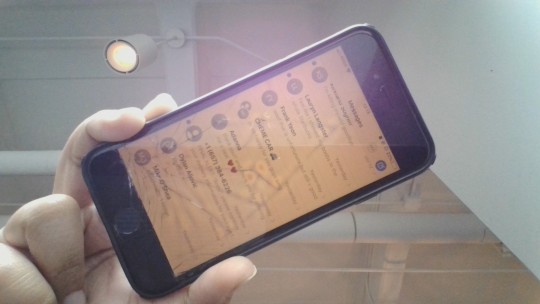



0 notes
Text
Another ‘Satoshi’ Steps Out of the Woodwork, Calls Craig Wright a Liar
Another ‘Satoshi’ Steps Out of the Woodwork, Calls Craig Wright a Liar
On Feb. 8, the chief executive of Nchain, Craig Wright, wrote a blog post that purportedly described his experience of creating Bitcoin. Wright’s essay states “I was Satoshi” but throughout the story, he refuses to reveal his keys. It’s not the first time Wright has claimed to be Satoshi, but in the comment section of his blog post, another character calls him a “liar” and claims that he is in fact the real Satoshi Nakamoto.
Also Read: Bitmain Announces New 7nm Bitcoin Mining Chip With 29% More Efficiency
So Many Satoshis With Zero Proof
It is difficult to figure out why someone would claim to be Satoshi without having the smoking gun that proves they are the creator of Bitcoin. Nevertheless, there’s been a number of self-professed Satoshis, but all of them have yet to convince the greater community. Craig Wright is probably the most famous of them all but news.Bitcoin.com has reported on various individuals who wholeheartedly believe they were involved with the creation of Bitcoin.
Recently, the notorious Wright has been writing memoirs about his experience in the early days when he allegedly invented the protocol. One specific post called “Careful what you wish for…” is one of the most telling tales he’s written in a while and the post caught a lot of flak from the community. Most of the antagonism towards it was because Wright stated he was Satoshi but also declared he does not have to prove it. Wright has also been criticized for speaking negatively about Ross Ulbricht, the Silk Road, Julian Assange, and Wikileaks.
This man believes he is Satoshi Nakamoto.
After the post was published, readers noticed another person in the essay’s comment section calling Wright a liar and claiming to be Satoshi Nakamoto.
“Liar — You, Dr. Craig Wright never had any digital key to sign, and no single proof of his claims — He could not even transact one bitcoin from my whale wallet,” explains the individual who believes he is Satoshi. “He did create an altcoin, BSV, then begged to convert bitcoin core into his crapcoin — Come on, you have nothing. You do not even know how I composed the genesis block and what I coded inside additionally.”
The commenter continues:
Yes, I do remember You, when You did try to trick me and ask me for a subkey. (Well, that was a dead end, I was warned by Hal about you.) Yes, I do remember our little IRC chat. And Your addiction to the dark world and the flattering of ego.
PGP Key 0x5EC948A1
The person also remarks by saying that when he digitally signs, he will show the world a registered, notary depot of his scientific paper (before the publication date on the internet) and the contents of the genesis block. Furthermore, the commenter left behind his Twitter handle @realsatoshin where he’s been telling people he is Satoshi for quite some time. The individual has 2,800 followers has tweeted publicly over 1,700 times. Many of the tweets declare he is the real Satoshi and explain that he will present himself in seven years. In the comment to Craig Wright, the person leaves the PGP key 0x5EC948A1 and explains that it was signed by Gavin and others in that time.
The individual has been tweeting about being Satoshi for quite some time.
Looking at the PGP key 0x5EC948A1 shows some interesting data and fingerprints that are tied to an email address [email protected] and other Satoshi related email handles. There are also a few unique dates tied to the PGP key’s data like Oct. 30, 2008, the day before the white paper published, and Jan. 3, 2009 the day the genesis block was born. Another interesting aspect to the key is it shows a revocation on May 2, 2016, the exact same day Gavin Andresen’s keys were revoked by Core developer Wladimir van der Laan.
The PGP Key 0x5EC948A1 is tethered to the email [email protected] and a few others. The PGP key has interesting fingerprints and dates associated with it.
On Jan. 6 the individual who believes he is Satoshi explained that he left the project for safety reasons and to protect the project. “A decentralized system needs no controllers and rulers, only the community,” he explained to his Twitter followers. The “Satoshin” character has also made numerous comments on other editorials detailing how he created the cryptocurrency and encoded his name into the chain. He also uses the name ‘nihsotas’ on Reddit and was very much involved in the discussion between the community and Gavin Andresen back in May 2016.
The Song Remains the Same: ‘Keys or GTFO’
The news also follows Craig Wright’s open letter to the U.S. Commodity Futures Trading Commission (CFTC) concerning the regulation of tokens and the Ethereum network. It seems Wright is willing to testify under oath that he was, in fact, the creator of Bitcoin.
“My name is Dr. Craig Wright and under the pseudonym of Satoshi Nakamoto I completed a project I started in 1997 that was filed with the Australian government in part under an AusIndustry project registered with the Dept. of Innovation as Blacknet,” explains the Australian native.
So far the community is hard set on only believing a person who signs Satoshi’s early keys and that goes for any self-proclaimed Bitcoin creator. “Keys or get the fuck out” is a common statement among crypto proponents, whereas so-called “easter eggs” and comments like “maybe I’ll tell you later” just doesn’t cut the mustard. The crypto community doesn’t believe the latest individual either. Even though he called Wright a liar, bitcoiners believe the new claimant is just another Wright clone fabricating tall tales, no different than the likes of Paul Bunyan.
What do you think about the individual who claims to be Satoshi and his 0x5EC948A1 PGP keys? Let us know what you think about this subject in the comments section below.
Image credits: Shutterstock, Pixabay, MIT PGP Database, and Twitter.
At news.Bitcoin.com all comments containing links are automatically held up for moderation in the Disqus system. That means an editor has to take a look at the comment to approve it. This is due to the many, repetitive, spam and scam links people post under our articles. We do not censor any comment content based on politics or personal opinions. So, please be patient. Your comment will be published.
Tags in this story
0x5EC948A1, Bitcoin, Bitcoin Core, Craig Wright, Early Keys, faketoshi, Gavin Andresen, Hunt for Satoshi Nakamoto, Julian Assange, keys, N-Featured, PGP Keys, Proof, Satoshi, Satoshi Nakamoto, Satoshin, [email protected], Silk Road, Whale Wallet, Wikileaks, Wladimir van der Laan
Jamie Redman
Jamie Redman is a financial tech journalist living in Florida. Redman has been an active member of the cryptocurrency community since 2011. He has a passion for Bitcoin, open source code, and decentralized applications. Redman has written thousands of articles for news.Bitcoin.com about the disruptive protocols emerging today.
Original Source https://ift.tt/2T8Hjhh
0 notes
Text
Another ‘Satoshi’ Steps Out of the Woodwork, Calls Craig Wright a Liar
Another ‘Satoshi’ Steps Out of the Woodwork, Calls Craig Wright a Liar
On Feb. 8, the chief executive of Nchain, Craig Wright, wrote a blog post that purportedly described his experience of creating Bitcoin. Wright’s essay states “I was Satoshi” but throughout the story, he refuses to reveal his keys. It’s not the first time Wright has claimed to be Satoshi, but in the comment section of his blog post, another character calls him a “liar” and claims that he is in fact the real Satoshi Nakamoto.
Also Read: Bitmain Announces New 7nm Bitcoin Mining Chip With 29% More Efficiency
So Many Satoshis With Zero Proof
It is difficult to figure out why someone would claim to be Satoshi without having the smoking gun that proves they are the creator of Bitcoin. Nevertheless, there’s been a number of self-professed Satoshis, but all of them have yet to convince the greater community. Craig Wright is probably the most famous of them all but news.Bitcoin.com has reported on various individuals who wholeheartedly believe they were involved with the creation of Bitcoin.
Recently, the notorious Wright has been writing memoirs about his experience in the early days when he allegedly invented the protocol. One specific post called “Careful what you wish for…” is one of the most telling tales he’s written in a while and the post caught a lot of flak from the community. Most of the antagonism towards it was because Wright stated he was Satoshi but also declared he does not have to prove it. Wright has also been criticized for speaking negatively about Ross Ulbricht, the Silk Road, Julian Assange, and Wikileaks.
This man believes he is Satoshi Nakamoto.
After the post was published, readers noticed another person in the essay’s comment section calling Wright a liar and claiming to be Satoshi Nakamoto.
“Liar — You, Dr. Craig Wright never had any digital key to sign, and no single proof of his claims — He could not even transact one bitcoin from my whale wallet,” explains the individual who believes he is Satoshi. “He did create an altcoin, BSV, then begged to convert bitcoin core into his crapcoin — Come on, you have nothing. You do not even know how I composed the genesis block and what I coded inside additionally.”
The commenter continues:
Yes, I do remember You, when You did try to trick me and ask me for a subkey. (Well, that was a dead end, I was warned by Hal about you.) Yes, I do remember our little IRC chat. And Your addiction to the dark world and the flattering of ego.
PGP Key 0x5EC948A1
The person also remarks by saying that when he digitally signs, he will show the world a registered, notary depot of his scientific paper (before the publication date on the internet) and the contents of the genesis block. Furthermore, the commenter left behind his Twitter handle @realsatoshin where he’s been telling people he is Satoshi for quite some time. The individual has 2,800 followers has tweeted publicly over 1,700 times. Many of the tweets declare he is the real Satoshi and explain that he will present himself in seven years. In the comment to Craig Wright, the person leaves the PGP key 0x5EC948A1 and explains that it was signed by Gavin and others in that time.
The individual has been tweeting about being Satoshi for quite some time.
Looking at the PGP key 0x5EC948A1 shows some interesting data and fingerprints that are tied to an email address [email protected] and other Satoshi related email handles. There are also a few unique dates tied to the PGP key’s data like Oct. 30, 2008, the day before the white paper published, and Jan. 3, 2009 the day the genesis block was born. Another interesting aspect to the key is it shows a revocation on May 2, 2016, the exact same day Gavin Andresen’s keys were revoked by Core developer Wladimir van der Laan.
The PGP Key 0x5EC948A1 is tethered to the email [email protected] and a few others. The PGP key has interesting fingerprints and dates associated with it.
On Jan. 6 the individual who believes he is Satoshi explained that he left the project for safety reasons and to protect the project. “A decentralized system needs no controllers and rulers, only the community,” he explained to his Twitter followers. The “Satoshin” character has also made numerous comments on other editorials detailing how he created the cryptocurrency and encoded his name into the chain. He also uses the name ‘nihsotas’ on Reddit and was very much involved in the discussion between the community and Gavin Andresen back in May 2016.
The Song Remains the Same: ‘Keys or GTFO’
The news also follows Craig Wright’s open letter to the U.S. Commodity Futures Trading Commission (CFTC) concerning the regulation of tokens and the Ethereum network. It seems Wright is willing to testify under oath that he was, in fact, the creator of Bitcoin.
“My name is Dr. Craig Wright and under the pseudonym of Satoshi Nakamoto I completed a project I started in 1997 that was filed with the Australian government in part under an AusIndustry project registered with the Dept. of Innovation as Blacknet,” explains the Australian native.
So far the community is hard set on only believing a person who signs Satoshi’s early keys and that goes for any self-proclaimed Bitcoin creator. “Keys or get the fuck out” is a common statement among crypto proponents, whereas so-called “easter eggs” and comments like “maybe I’ll tell you later” just doesn’t cut the mustard. The crypto community doesn’t believe the latest individual either. Even though he called Wright a liar, bitcoiners believe the new claimant is just another Wright clone fabricating tall tales, no different than the likes of Paul Bunyan.
What do you think about the individual who claims to be Satoshi and his 0x5EC948A1 PGP keys? Let us know what you think about this subject in the comments section below.
Image credits: Shutterstock, Pixabay, MIT PGP Database, and Twitter.
At news.Bitcoin.com all comments containing links are automatically held up for moderation in the Disqus system. That means an editor has to take a look at the comment to approve it. This is due to the many, repetitive, spam and scam links people post under our articles. We do not censor any comment content based on politics or personal opinions. So, please be patient. Your comment will be published.
Tags in this story
0x5EC948A1, Bitcoin, Bitcoin Core, Craig Wright, Early Keys, faketoshi, Gavin Andresen, Hunt for Satoshi Nakamoto, Julian Assange, keys, N-Featured, PGP Keys, Proof, Satoshi, Satoshi Nakamoto, Satoshin, [email protected], Silk Road, Whale Wallet, Wikileaks, Wladimir van der Laan
Jamie Redman
Jamie Redman is a financial tech journalist living in Florida. Redman has been an active member of the cryptocurrency community since 2011. He has a passion for Bitcoin, open source code, and decentralized applications. Redman has written thousands of articles for news.Bitcoin.com about the disruptive protocols emerging today.
Original Source https://ift.tt/2T8Hjhh
0 notes
Text
Another ‘Satoshi’ Steps Out of the Woodwork, Calls Craig Wright a Liar
Another ‘Satoshi’ Steps Out of the Woodwork, Calls Craig Wright a Liar
On Feb. 8, the chief executive of Nchain, Craig Wright, wrote a blog post that purportedly described his experience of creating Bitcoin. Wright’s essay states “I was Satoshi” but throughout the story, he refuses to reveal his keys. It’s not the first time Wright has claimed to be Satoshi, but in the comment section of his blog post, another character calls him a “liar” and claims that he is in fact the real Satoshi Nakamoto.
Also Read: Bitmain Announces New 7nm Bitcoin Mining Chip With 29% More Efficiency
So Many Satoshis With Zero Proof
It is difficult to figure out why someone would claim to be Satoshi without having the smoking gun that proves they are the creator of Bitcoin. Nevertheless, there’s been a number of self-professed Satoshis, but all of them have yet to convince the greater community. Craig Wright is probably the most famous of them all but news.Bitcoin.com has reported on various individuals who wholeheartedly believe they were involved with the creation of Bitcoin.
Recently, the notorious Wright has been writing memoirs about his experience in the early days when he allegedly invented the protocol. One specific post called “Careful what you wish for…” is one of the most telling tales he’s written in a while and the post caught a lot of flak from the community. Most of the antagonism towards it was because Wright stated he was Satoshi but also declared he does not have to prove it. Wright has also been criticized for speaking negatively about Ross Ulbricht, the Silk Road, Julian Assange, and Wikileaks.
This man believes he is Satoshi Nakamoto.
After the post was published, readers noticed another person in the essay’s comment section calling Wright a liar and claiming to be Satoshi Nakamoto.
“Liar — You, Dr. Craig Wright never had any digital key to sign, and no single proof of his claims — He could not even transact one bitcoin from my whale wallet,” explains the individual who believes he is Satoshi. “He did create an altcoin, BSV, then begged to convert bitcoin core into his crapcoin — Come on, you have nothing. You do not even know how I composed the genesis block and what I coded inside additionally.”
The commenter continues:
Yes, I do remember You, when You did try to trick me and ask me for a subkey. (Well, that was a dead end, I was warned by Hal about you.) Yes, I do remember our little IRC chat. And Your addiction to the dark world and the flattering of ego.
PGP Key 0x5EC948A1
The person also remarks by saying that when he digitally signs, he will show the world a registered, notary depot of his scientific paper (before the publication date on the internet) and the contents of the genesis block. Furthermore, the commenter left behind his Twitter handle @realsatoshin where he’s been telling people he is Satoshi for quite some time. The individual has 2,800 followers has tweeted publicly over 1,700 times. Many of the tweets declare he is the real Satoshi and explain that he will present himself in seven years. In the comment to Craig Wright, the person leaves the PGP key 0x5EC948A1 and explains that it was signed by Gavin and others in that time.
The individual has been tweeting about being Satoshi for quite some time.
Looking at the PGP key 0x5EC948A1 shows some interesting data and fingerprints that are tied to an email address [email protected] and other Satoshi related email handles. There are also a few unique dates tied to the PGP key’s data like Oct. 30, 2008, the day before the white paper published, and Jan. 3, 2009 the day the genesis block was born. Another interesting aspect to the key is it shows a revocation on May 2, 2016, the exact same day Gavin Andresen’s keys were revoked by Core developer Wladimir van der Laan.
The PGP Key 0x5EC948A1 is tethered to the email [email protected] and a few others. The PGP key has interesting fingerprints and dates associated with it.
On Jan. 6 the individual who believes he is Satoshi explained that he left the project for safety reasons and to protect the project. “A decentralized system needs no controllers and rulers, only the community,” he explained to his Twitter followers. The “Satoshin” character has also made numerous comments on other editorials detailing how he created the cryptocurrency and encoded his name into the chain. He also uses the name ‘nihsotas’ on Reddit and was very much involved in the discussion between the community and Gavin Andresen back in May 2016.
The Song Remains the Same: ‘Keys or GTFO’
The news also follows Craig Wright’s open letter to the U.S. Commodity Futures Trading Commission (CFTC) concerning the regulation of tokens and the Ethereum network. It seems Wright is willing to testify under oath that he was, in fact, the creator of Bitcoin.
“My name is Dr. Craig Wright and under the pseudonym of Satoshi Nakamoto I completed a project I started in 1997 that was filed with the Australian government in part under an AusIndustry project registered with the Dept. of Innovation as Blacknet,” explains the Australian native.
So far the community is hard set on only believing a person who signs Satoshi’s early keys and that goes for any self-proclaimed Bitcoin creator. “Keys or get the fuck out” is a common statement among crypto proponents, whereas so-called “easter eggs” and comments like “maybe I’ll tell you later” just doesn’t cut the mustard. The crypto community doesn’t believe the latest individual either. Even though he called Wright a liar, bitcoiners believe the new claimant is just another Wright clone fabricating tall tales, no different than the likes of Paul Bunyan.
What do you think about the individual who claims to be Satoshi and his 0x5EC948A1 PGP keys? Let us know what you think about this subject in the comments section below.
Image credits: Shutterstock, Pixabay, MIT PGP Database, and Twitter.
At news.Bitcoin.com all comments containing links are automatically held up for moderation in the Disqus system. That means an editor has to take a look at the comment to approve it. This is due to the many, repetitive, spam and scam links people post under our articles. We do not censor any comment content based on politics or personal opinions. So, please be patient. Your comment will be published.
Tags in this story
0x5EC948A1, Bitcoin, Bitcoin Core, Craig Wright, Early Keys, faketoshi, Gavin Andresen, Hunt for Satoshi Nakamoto, Julian Assange, keys, N-Featured, PGP Keys, Proof, Satoshi, Satoshi Nakamoto, Satoshin, [email protected], Silk Road, Whale Wallet, Wikileaks, Wladimir van der Laan
Jamie Redman
Jamie Redman is a financial tech journalist living in Florida. Redman has been an active member of the cryptocurrency community since 2011. He has a passion for Bitcoin, open source code, and decentralized applications. Redman has written thousands of articles for news.Bitcoin.com about the disruptive protocols emerging today.
Original Source https://ift.tt/2T8Hjhh
0 notes
Text
Another ‘Satoshi’ Steps Out of the Woodwork, Calls Craig Wright a Liar
Another ‘Satoshi’ Steps Out of the Woodwork, Calls Craig Wright a Liar
On Feb. 8, the chief executive of Nchain, Craig Wright, wrote a blog post that purportedly described his experience of creating Bitcoin. Wright’s essay states “I was Satoshi” but throughout the story, he refuses to reveal his keys. It’s not the first time Wright has claimed to be Satoshi, but in the comment section of his blog post, another character calls him a “liar” and claims that he is in fact the real Satoshi Nakamoto.
Also Read: Bitmain Announces New 7nm Bitcoin Mining Chip With 29% More Efficiency
So Many Satoshis With Zero Proof
It is difficult to figure out why someone would claim to be Satoshi without having the smoking gun that proves they are the creator of Bitcoin. Nevertheless, there’s been a number of self-professed Satoshis, but all of them have yet to convince the greater community. Craig Wright is probably the most famous of them all but news.Bitcoin.com has reported on various individuals who wholeheartedly believe they were involved with the creation of Bitcoin.
Recently, the notorious Wright has been writing memoirs about his experience in the early days when he allegedly invented the protocol. One specific post called “Careful what you wish for…” is one of the most telling tales he’s written in a while and the post caught a lot of flak from the community. Most of the antagonism towards it was because Wright stated he was Satoshi but also declared he does not have to prove it. Wright has also been criticized for speaking negatively about Ross Ulbricht, the Silk Road, Julian Assange, and Wikileaks.
This man believes he is Satoshi Nakamoto.
After the post was published, readers noticed another person in the essay’s comment section calling Wright a liar and claiming to be Satoshi Nakamoto.
“Liar — You, Dr. Craig Wright never had any digital key to sign, and no single proof of his claims — He could not even transact one bitcoin from my whale wallet,” explains the individual who believes he is Satoshi. “He did create an altcoin, BSV, then begged to convert bitcoin core into his crapcoin — Come on, you have nothing. You do not even know how I composed the genesis block and what I coded inside additionally.”
The commenter continues:
Yes, I do remember You, when You did try to trick me and ask me for a subkey. (Well, that was a dead end, I was warned by Hal about you.) Yes, I do remember our little IRC chat. And Your addiction to the dark world and the flattering of ego.
PGP Key 0x5EC948A1
The person also remarks by saying that when he digitally signs, he will show the world a registered, notary depot of his scientific paper (before the publication date on the internet) and the contents of the genesis block. Furthermore, the commenter left behind his Twitter handle @realsatoshin where he’s been telling people he is Satoshi for quite some time. The individual has 2,800 followers has tweeted publicly over 1,700 times. Many of the tweets declare he is the real Satoshi and explain that he will present himself in seven years. In the comment to Craig Wright, the person leaves the PGP key 0x5EC948A1 and explains that it was signed by Gavin and others in that time.
The individual has been tweeting about being Satoshi for quite some time.
Looking at the PGP key 0x5EC948A1 shows some interesting data and fingerprints that are tied to an email address [email protected] and other Satoshi related email handles. There are also a few unique dates tied to the PGP key’s data like Oct. 30, 2008, the day before the white paper published, and Jan. 3, 2009 the day the genesis block was born. Another interesting aspect to the key is it shows a revocation on May 2, 2016, the exact same day Gavin Andresen’s keys were revoked by Core developer Wladimir van der Laan.
The PGP Key 0x5EC948A1 is tethered to the email [email protected] and a few others. The PGP key has interesting fingerprints and dates associated with it.
On Jan. 6 the individual who believes he is Satoshi explained that he left the project for safety reasons and to protect the project. “A decentralized system needs no controllers and rulers, only the community,” he explained to his Twitter followers. The “Satoshin” character has also made numerous comments on other editorials detailing how he created the cryptocurrency and encoded his name into the chain. He also uses the name ‘nihsotas’ on Reddit and was very much involved in the discussion between the community and Gavin Andresen back in May 2016.
The Song Remains the Same: ‘Keys or GTFO’
The news also follows Craig Wright’s open letter to the U.S. Commodity Futures Trading Commission (CFTC) concerning the regulation of tokens and the Ethereum network. It seems Wright is willing to testify under oath that he was, in fact, the creator of Bitcoin.
“My name is Dr. Craig Wright and under the pseudonym of Satoshi Nakamoto I completed a project I started in 1997 that was filed with the Australian government in part under an AusIndustry project registered with the Dept. of Innovation as Blacknet,” explains the Australian native.
So far the community is hard set on only believing a person who signs Satoshi’s early keys and that goes for any self-proclaimed Bitcoin creator. “Keys or get the fuck out” is a common statement among crypto proponents, whereas so-called “easter eggs” and comments like “maybe I’ll tell you later” just doesn’t cut the mustard. The crypto community doesn’t believe the latest individual either. Even though he called Wright a liar, bitcoiners believe the new claimant is just another Wright clone fabricating tall tales, no different than the likes of Paul Bunyan.
What do you think about the individual who claims to be Satoshi and his 0x5EC948A1 PGP keys? Let us know what you think about this subject in the comments section below.
Image credits: Shutterstock, Pixabay, MIT PGP Database, and Twitter.
At news.Bitcoin.com all comments containing links are automatically held up for moderation in the Disqus system. That means an editor has to take a look at the comment to approve it. This is due to the many, repetitive, spam and scam links people post under our articles. We do not censor any comment content based on politics or personal opinions. So, please be patient. Your comment will be published.
Tags in this story
0x5EC948A1, Bitcoin, Bitcoin Core, Craig Wright, Early Keys, faketoshi, Gavin Andresen, Hunt for Satoshi Nakamoto, Julian Assange, keys, N-Featured, PGP Keys, Proof, Satoshi, Satoshi Nakamoto, Satoshin, [email protected], Silk Road, Whale Wallet, Wikileaks, Wladimir van der Laan
Jamie Redman
Jamie Redman is a financial tech journalist living in Florida. Redman has been an active member of the cryptocurrency community since 2011. He has a passion for Bitcoin, open source code, and decentralized applications. Redman has written thousands of articles for news.Bitcoin.com about the disruptive protocols emerging today.
Original Source https://ift.tt/2T8Hjhh
0 notes
Text
Another ‘Satoshi’ Steps Out of the Woodwork, Calls Craig Wright a Liar
Another ‘Satoshi’ Steps Out of the Woodwork, Calls Craig Wright a Liar
On Feb. 8, the chief executive of Nchain, Craig Wright, wrote a blog post that purportedly described his experience of creating Bitcoin. Wright’s essay states “I was Satoshi” but throughout the story, he refuses to reveal his keys. It’s not the first time Wright has claimed to be Satoshi, but in the comment section of his blog post, another character calls him a “liar” and claims that he is in fact the real Satoshi Nakamoto.
Also Read: Bitmain Announces New 7nm Bitcoin Mining Chip With 29% More Efficiency
So Many Satoshis With Zero Proof
It is difficult to figure out why someone would claim to be Satoshi without having the smoking gun that proves they are the creator of Bitcoin. Nevertheless, there’s been a number of self-professed Satoshis, but all of them have yet to convince the greater community. Craig Wright is probably the most famous of them all but news.Bitcoin.com has reported on various individuals who wholeheartedly believe they were involved with the creation of Bitcoin.
Recently, the notorious Wright has been writing memoirs about his experience in the early days when he allegedly invented the protocol. One specific post called “Careful what you wish for…” is one of the most telling tales he’s written in a while and the post caught a lot of flak from the community. Most of the antagonism towards it was because Wright stated he was Satoshi but also declared he does not have to prove it. Wright has also been criticized for speaking negatively about Ross Ulbricht, the Silk Road, Julian Assange, and Wikileaks.
This man believes he is Satoshi Nakamoto.
After the post was published, readers noticed another person in the essay’s comment section calling Wright a liar and claiming to be Satoshi Nakamoto.
“Liar — You, Dr. Craig Wright never had any digital key to sign, and no single proof of his claims — He could not even transact one bitcoin from my whale wallet,” explains the individual who believes he is Satoshi. “He did create an altcoin, BSV, then begged to convert bitcoin core into his crapcoin — Come on, you have nothing. You do not even know how I composed the genesis block and what I coded inside additionally.”
The commenter continues:
Yes, I do remember You, when You did try to trick me and ask me for a subkey. (Well, that was a dead end, I was warned by Hal about you.) Yes, I do remember our little IRC chat. And Your addiction to the dark world and the flattering of ego.
PGP Key 0x5EC948A1
The person also remarks by saying that when he digitally signs, he will show the world a registered, notary depot of his scientific paper (before the publication date on the internet) and the contents of the genesis block. Furthermore, the commenter left behind his Twitter handle @realsatoshin where he’s been telling people he is Satoshi for quite some time. The individual has 2,800 followers has tweeted publicly over 1,700 times. Many of the tweets declare he is the real Satoshi and explain that he will present himself in seven years. In the comment to Craig Wright, the person leaves the PGP key 0x5EC948A1 and explains that it was signed by Gavin and others in that time.
The individual has been tweeting about being Satoshi for quite some time.
Looking at the PGP key 0x5EC948A1 shows some interesting data and fingerprints that are tied to an email address [email protected] and other Satoshi related email handles. There are also a few unique dates tied to the PGP key’s data like Oct. 30, 2008, the day before the white paper published, and Jan. 3, 2009 the day the genesis block was born. Another interesting aspect to the key is it shows a revocation on May 2, 2016, the exact same day Gavin Andresen’s keys were revoked by Core developer Wladimir van der Laan.
The PGP Key 0x5EC948A1 is tethered to the email [email protected] and a few others. The PGP key has interesting fingerprints and dates associated with it.
On Jan. 6 the individual who believes he is Satoshi explained that he left the project for safety reasons and to protect the project. “A decentralized system needs no controllers and rulers, only the community,” he explained to his Twitter followers. The “Satoshin” character has also made numerous comments on other editorials detailing how he created the cryptocurrency and encoded his name into the chain. He also uses the name ‘nihsotas’ on Reddit and was very much involved in the discussion between the community and Gavin Andresen back in May 2016.
The Song Remains the Same: ‘Keys or GTFO’
The news also follows Craig Wright’s open letter to the U.S. Commodity Futures Trading Commission (CFTC) concerning the regulation of tokens and the Ethereum network. It seems Wright is willing to testify under oath that he was, in fact, the creator of Bitcoin.
“My name is Dr. Craig Wright and under the pseudonym of Satoshi Nakamoto I completed a project I started in 1997 that was filed with the Australian government in part under an AusIndustry project registered with the Dept. of Innovation as Blacknet,” explains the Australian native.
So far the community is hard set on only believing a person who signs Satoshi’s early keys and that goes for any self-proclaimed Bitcoin creator. “Keys or get the fuck out” is a common statement among crypto proponents, whereas so-called “easter eggs” and comments like “maybe I’ll tell you later” just doesn’t cut the mustard. The crypto community doesn’t believe the latest individual either. Even though he called Wright a liar, bitcoiners believe the new claimant is just another Wright clone fabricating tall tales, no different than the likes of Paul Bunyan.
What do you think about the individual who claims to be Satoshi and his 0x5EC948A1 PGP keys? Let us know what you think about this subject in the comments section below.
Image credits: Shutterstock, Pixabay, MIT PGP Database, and Twitter.
At news.Bitcoin.com all comments containing links are automatically held up for moderation in the Disqus system. That means an editor has to take a look at the comment to approve it. This is due to the many, repetitive, spam and scam links people post under our articles. We do not censor any comment content based on politics or personal opinions. So, please be patient. Your comment will be published.
Tags in this story
0x5EC948A1, Bitcoin, Bitcoin Core, Craig Wright, Early Keys, faketoshi, Gavin Andresen, Hunt for Satoshi Nakamoto, Julian Assange, keys, N-Featured, PGP Keys, Proof, Satoshi, Satoshi Nakamoto, Satoshin, [email protected], Silk Road, Whale Wallet, Wikileaks, Wladimir van der Laan
Jamie Redman
Jamie Redman is a financial tech journalist living in Florida. Redman has been an active member of the cryptocurrency community since 2011. He has a passion for Bitcoin, open source code, and decentralized applications. Redman has written thousands of articles for news.Bitcoin.com about the disruptive protocols emerging today.
Original Source https://ift.tt/2T8Hjhh
0 notes
Text
Another ‘Satoshi’ Steps Out of the Woodwork, Calls Craig Wright a Liar
Another ‘Satoshi’ Steps Out of the Woodwork, Calls Craig Wright a Liar
On Feb. 8, the chief executive of Nchain, Craig Wright, wrote a blog post that purportedly described his experience of creating Bitcoin. Wright’s essay states “I was Satoshi” but throughout the story, he refuses to reveal his keys. It’s not the first time Wright has claimed to be Satoshi, but in the comment section of his blog post, another character calls him a “liar” and claims that he is in fact the real Satoshi Nakamoto.
Also Read: Bitmain Announces New 7nm Bitcoin Mining Chip With 29% More Efficiency
So Many Satoshis With Zero Proof
It is difficult to figure out why someone would claim to be Satoshi without having the smoking gun that proves they are the creator of Bitcoin. Nevertheless, there’s been a number of self-professed Satoshis, but all of them have yet to convince the greater community. Craig Wright is probably the most famous of them all but news.Bitcoin.com has reported on various individuals who wholeheartedly believe they were involved with the creation of Bitcoin.
Recently, the notorious Wright has been writing memoirs about his experience in the early days when he allegedly invented the protocol. One specific post called “Careful what you wish for…” is one of the most telling tales he’s written in a while and the post caught a lot of flak from the community. Most of the antagonism towards it was because Wright stated he was Satoshi but also declared he does not have to prove it. Wright has also been criticized for speaking negatively about Ross Ulbricht, the Silk Road, Julian Assange, and Wikileaks.
This man believes he is Satoshi Nakamoto.
After the post was published, readers noticed another person in the essay’s comment section calling Wright a liar and claiming to be Satoshi Nakamoto.
“Liar — You, Dr. Craig Wright never had any digital key to sign, and no single proof of his claims — He could not even transact one bitcoin from my whale wallet,” explains the individual who believes he is Satoshi. “He did create an altcoin, BSV, then begged to convert bitcoin core into his crapcoin — Come on, you have nothing. You do not even know how I composed the genesis block and what I coded inside additionally.”
The commenter continues:
Yes, I do remember You, when You did try to trick me and ask me for a subkey. (Well, that was a dead end, I was warned by Hal about you.) Yes, I do remember our little IRC chat. And Your addiction to the dark world and the flattering of ego.
PGP Key 0x5EC948A1
The person also remarks by saying that when he digitally signs, he will show the world a registered, notary depot of his scientific paper (before the publication date on the internet) and the contents of the genesis block. Furthermore, the commenter left behind his Twitter handle @realsatoshin where he’s been telling people he is Satoshi for quite some time. The individual has 2,800 followers has tweeted publicly over 1,700 times. Many of the tweets declare he is the real Satoshi and explain that he will present himself in seven years. In the comment to Craig Wright, the person leaves the PGP key 0x5EC948A1 and explains that it was signed by Gavin and others in that time.
The individual has been tweeting about being Satoshi for quite some time.
Looking at the PGP key 0x5EC948A1 shows some interesting data and fingerprints that are tied to an email address [email protected] and other Satoshi related email handles. There are also a few unique dates tied to the PGP key’s data like Oct. 30, 2008, the day before the white paper published, and Jan. 3, 2009 the day the genesis block was born. Another interesting aspect to the key is it shows a revocation on May 2, 2016, the exact same day Gavin Andresen’s keys were revoked by Core developer Wladimir van der Laan.
The PGP Key 0x5EC948A1 is tethered to the email [email protected] and a few others. The PGP key has interesting fingerprints and dates associated with it.
On Jan. 6 the individual who believes he is Satoshi explained that he left the project for safety reasons and to protect the project. “A decentralized system needs no controllers and rulers, only the community,” he explained to his Twitter followers. The “Satoshin” character has also made numerous comments on other editorials detailing how he created the cryptocurrency and encoded his name into the chain. He also uses the name ‘nihsotas’ on Reddit and was very much involved in the discussion between the community and Gavin Andresen back in May 2016.
The Song Remains the Same: ‘Keys or GTFO’
The news also follows Craig Wright’s open letter to the U.S. Commodity Futures Trading Commission (CFTC) concerning the regulation of tokens and the Ethereum network. It seems Wright is willing to testify under oath that he was, in fact, the creator of Bitcoin.
“My name is Dr. Craig Wright and under the pseudonym of Satoshi Nakamoto I completed a project I started in 1997 that was filed with the Australian government in part under an AusIndustry project registered with the Dept. of Innovation as Blacknet,” explains the Australian native.
So far the community is hard set on only believing a person who signs Satoshi’s early keys and that goes for any self-proclaimed Bitcoin creator. “Keys or get the fuck out” is a common statement among crypto proponents, whereas so-called “easter eggs” and comments like “maybe I’ll tell you later” just doesn’t cut the mustard. The crypto community doesn’t believe the latest individual either. Even though he called Wright a liar, bitcoiners believe the new claimant is just another Wright clone fabricating tall tales, no different than the likes of Paul Bunyan.
What do you think about the individual who claims to be Satoshi and his 0x5EC948A1 PGP keys? Let us know what you think about this subject in the comments section below.
Image credits: Shutterstock, Pixabay, MIT PGP Database, and Twitter.
At news.Bitcoin.com all comments containing links are automatically held up for moderation in the Disqus system. That means an editor has to take a look at the comment to approve it. This is due to the many, repetitive, spam and scam links people post under our articles. We do not censor any comment content based on politics or personal opinions. So, please be patient. Your comment will be published.
Tags in this story
0x5EC948A1, Bitcoin, Bitcoin Core, Craig Wright, Early Keys, faketoshi, Gavin Andresen, Hunt for Satoshi Nakamoto, Julian Assange, keys, N-Featured, PGP Keys, Proof, Satoshi, Satoshi Nakamoto, Satoshin, [email protected], Silk Road, Whale Wallet, Wikileaks, Wladimir van der Laan
Jamie Redman
Jamie Redman is a financial tech journalist living in Florida. Redman has been an active member of the cryptocurrency community since 2011. He has a passion for Bitcoin, open source code, and decentralized applications. Redman has written thousands of articles for news.Bitcoin.com about the disruptive protocols emerging today.
Original Source https://ift.tt/2T8Hjhh
0 notes
Text
Another ‘Satoshi’ Steps Out of the Woodwork, Calls Craig Wright a Liar
On Feb. 8, the chief executive of Nchain, Craig Wright, wrote a blog post that purportedly described his experience of creating Bitcoin. Wright’s essay states “I was Satoshi” but throughout the story, he refuses to reveal his keys. It’s not the first time Wright has claimed to be Satoshi, but in the comment section of his blog post, another character calls him a “liar” and claims that he is in fact the real Satoshi Nakamoto.
Also Read: Bitmain Announces New 7nm Bitcoin Mining Chip With 29% More Efficiency
So Many Satoshis With Zero Proof
It is difficult to figure out why someone would claim to be Satoshi without having the smoking gun that proves they are the creator of Bitcoin. Nevertheless, there’s been a number of self-professed Satoshis, but all of them have yet to convince the greater community. Craig Wright is probably the most famous of them all but news.Bitcoin.com has reported on various individuals who wholeheartedly believe they were involved with the creation of Bitcoin.
Recently, the notorious Wright has been writing memoirs about his experience in the early days when he allegedly invented the protocol. One specific post called “Careful what you wish for…” is one of the most telling tales he’s written in a while and the post caught a lot of flak from the community. Most of the antagonism towards it was because Wright stated he was Satoshi but also declared he does not have to prove it. Wright has also been criticized for speaking negatively about Ross Ulbricht, the Silk Road, Julian Assange, and Wikileaks.
This man believes he is Satoshi Nakamoto.
After the post was published, readers noticed another person in the essay’s comment section calling Wright a liar and claiming to be Satoshi Nakamoto.
“Liar — You, Dr. Craig Wright never had any digital key to sign, and no single proof of his claims — He could not even transact one bitcoin from my whale wallet,” explains the individual who believes he is Satoshi. “He did create an altcoin, BSV, then begged to convert bitcoin core into his crapcoin — Come on, you have nothing. You do not even know how I composed the genesis block and what I coded inside additionally.”
The commenter continues:
Yes, I do remember You, when You did try to trick me and ask me for a subkey. (Well, that was a dead end, I was warned by Hal about you.) Yes, I do remember our little IRC chat. And Your addiction to the dark world and the flattering of ego.
PGP Key 0x5EC948A1
The person also remarks by saying that when he digitally signs, he will show the world a registered, notary depot of his scientific paper (before the publication date on the internet) and the contents of the genesis block. Furthermore, the commenter left behind his Twitter handle @realsatoshin where he’s been telling people he is Satoshi for quite some time. The individual has 2,800 followers has tweeted publicly over 1,700 times. Many of the tweets declare he is the real Satoshi and explain that he will present himself in seven years. In the comment to Craig Wright, the person leaves the PGP key 0x5EC948A1 and explains that it was signed by Gavin and others in that time.
The individual has been tweeting about being Satoshi for quite some time.
Looking at the PGP key 0x5EC948A1 shows some interesting data and fingerprints that are tied to an email address [email protected] and other Satoshi related email handles. There are also a few unique dates tied to the PGP key’s data like Oct. 30, 2008, the day before the white paper published, and Jan. 3, 2009 the day the genesis block was born. Another interesting aspect to the key is it shows a revocation on May 2, 2016, the exact same day Gavin Andresen’s keys were revoked by Core developer Wladimir van der Laan.
The PGP Key 0x5EC948A1 is tethered to the email [email protected] and a few others. The PGP key has interesting fingerprints and dates associated with it.
On Jan. 6 the individual who believes he is Satoshi explained that he left the project for safety reasons and to protect the project. “A decentralized system needs no controllers and rulers, only the community,” he explained to his Twitter followers. The “Satoshin” character has also made numerous comments on other editorials detailing how he created the cryptocurrency and encoded his name into the chain. He also uses the name ‘nihsotas’ on Reddit and was very much involved in the discussion between the community and Gavin Andresen back in May 2016.
The Song Remains the Same: ‘Keys or GTFO’
The news also follows Craig Wright’s open letter to the U.S. Commodity Futures Trading Commission (CFTC) concerning the regulation of tokens and the Ethereum network. It seems Wright is willing to testify under oath that he was, in fact, the creator of Bitcoin.
“My name is Dr. Craig Wright and under the pseudonym of Satoshi Nakamoto I completed a project I started in 1997 that was filed with the Australian government in part under an AusIndustry project registered with the Dept. of Innovation as Blacknet,” explains the Australian native.
So far the community is hard set on only believing a person who signs Satoshi’s early keys and that goes for any self-proclaimed Bitcoin creator. “Keys or get the fuck out” is a common statement among crypto proponents, whereas so-called “easter eggs” and comments like “maybe I’ll tell you later” just doesn’t cut the mustard. The crypto community doesn’t believe the latest individual either. Even though he called Wright a liar, bitcoiners believe the new claimant is just another Wright clone fabricating tall tales, no different than the likes of Paul Bunyan.
What do you think about the individual who claims to be Satoshi and his 0x5EC948A1 PGP keys? Let us know what you think about this subject in the comments section below.
Image credits: Shutterstock, Pixabay, MIT PGP Database, and Twitter.
At news.Bitcoin.com all comments containing links are automatically held up for moderation in the Disqus system. That means an editor has to take a look at the comment to approve it. This is due to the many, repetitive, spam and scam links people post under our articles. We do not censor any comment content based on politics or personal opinions. So, please be patient. Your comment will be published.
The post Another ‘Satoshi’ Steps Out of the Woodwork, Calls Craig Wright a Liar appeared first on Bitcoin News.
[Telegram Channel | Original Article ]
0 notes
Text
Can exercise help conquer addiction?
As an athlete, I think regularly about the potential health benefits of exercise for my patients. Every week, I treat patients hospitalized at Brigham and Women’s Hospital with significant medical problems that are a direct result of severe addiction, ranging from seizures and strokes to heart valve and joint infections. I also care for outpatients at the Brigham and Women’s Faulkner Hospital Addiction Recovery Program. In both settings, I provide medication-assisted treatment (MAT) such as buprenorphine-naloxone for opioid use disorder, and extended-release naltrexone for both alcohol use disorder and opioid use disorder. I work closely with therapists and social workers who offer our patients counseling and referrals to additional programs. I frequently discuss mutual-help groups such as Alcoholics Anonymous and SMART Recovery with patients. I use motivational interviewing techniques to help enhance motivation and guide patients towards their recovery goals.
Suffice to say, I am a psychiatrist interested in pulling out all of the stops when it comes to treating addiction.
Despite increased national attention and numerous interventions to tackle the opioid epidemic, recent statistics are still alarming. Drug overdose deaths involving synthetic opioids increased by 87% annually from 2013 to 2016. This dramatic increase is attributed mainly to the illicit manufacturing of fentanyl, an opioid approximately 100 times more potent than morphine. In Massachusetts, where I practice, rates of overdose deaths from all drugs ranked eighth highest in the country in 2016.
Does exercise help people in recovery from addiction?
Combined with what we know about other treatments, exercise shows promise. Animal studies have shown that regular swimming reduces voluntary morphine consumption in opioid-dependent rats, and access to an exercise wheel reduces self-administration of cocaine in rats dependent on the drug. A small study in humans investigated an exercise program offered to 38 men and women who misused a variety of substances, including opioids, cannabis, amphetamines, and cocaine. Participants agreed to take part in group exercise three times a week for two to six months. Twenty people completed the intervention. When reassessed a year later, five reported abstinence and 10 reported that they had decreased their substance use.
In my experience, many patients with various substance use disorders have found that exercise helps to distract them from cravings. Workouts add structure to the day. They help with forming positive social connections, and help treat depression and anxiety in combination with other therapies.
Forging positive connections with others in recovery
Organizations promoting physical activity for people in recovery continue to grow. The Boston Bulldogs Running Club, which dates back to 2008, has broadened its mission to support people with addiction and their friends and families. This nonprofit organization also promotes wellness to children and teens to help prevent substance use disorders.
The Phoenix, another nonprofit organization, aims to build an active community of sober individuals through peer-led CrossFit, yoga, rock climbing, boxing, running, and hiking events. Created in 2006, it has expanded to offer free programming in a number of states. Phoenix events are open to anyone with at least 48 hours of sobriety, and to supporters of those in recovery. I recently worked up a sweat in a Phoenix CrossFit class in Boston. The camaraderie during the workout was palpable, and it was inspiring to witness the dedication of the coaches in recovery.
Is it best to combine exercise with other addiction treatments?
Medication-assisted treatment at least doubles the rates of opioid abstinence. Staying on long-term MAT is often recommended. Studies show a greater than a 50% chance of relapsing on illicit opioids just one month after discontinuing treatment with buprenorphine-naloxone. For people with opioid addiction, continuing to take methadone or buprenorphine-naloxone substantially lowers the risk of dying from an overdose. Consistently taking these medications also decreases the risk of death related to other causes.
Psychotherapy is often a recommended component of substance use treatment as well. No medication is perfect, and addiction has an impact on many dimensions of a person’s life.
In summary, I vote that yes, there is some evidence that exercise can help to conquer addiction. No treatment is infallible. Frequently, people with substance abuse disorders find that a variety of strategies is best, including MAT, psychotherapy, and mutual-help groups. More research is needed to clarify which types and amounts of exercise are potentially helpful in treating addiction. I look forward to watching organizations like The Boston Bulldogs and The Phoenix continue to grow, and I plan to continue recommending groups like these to patients.
Follow me on Twitter @clairetwarkmd
The post Can exercise help conquer addiction? appeared first on Harvard Health Blog.
Can exercise help conquer addiction? published first on https://brightendentalhouston.tumblr.com/
0 notes